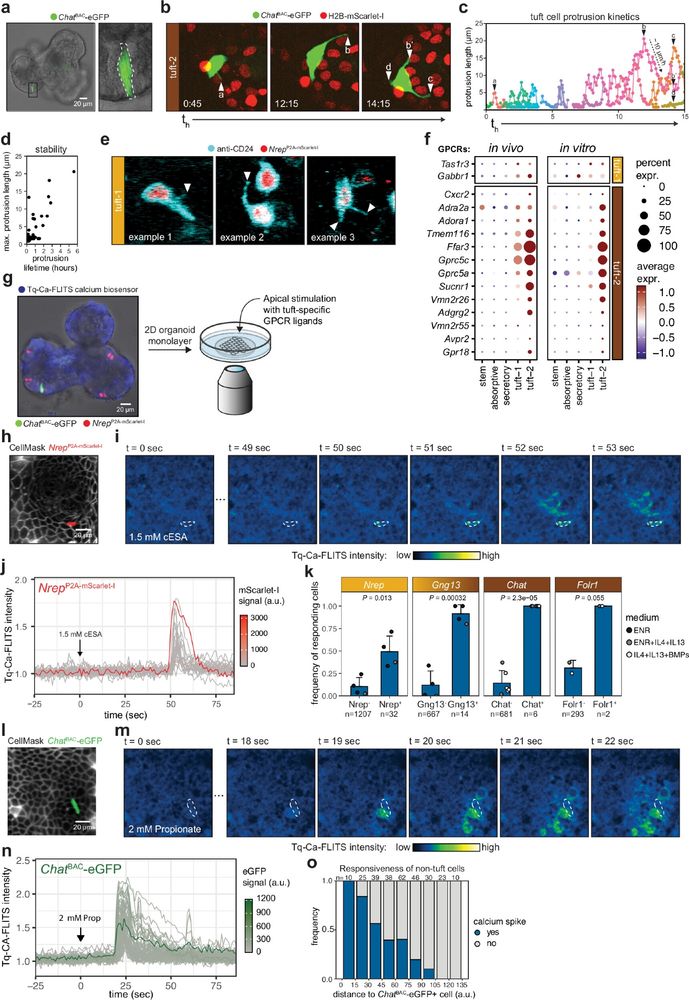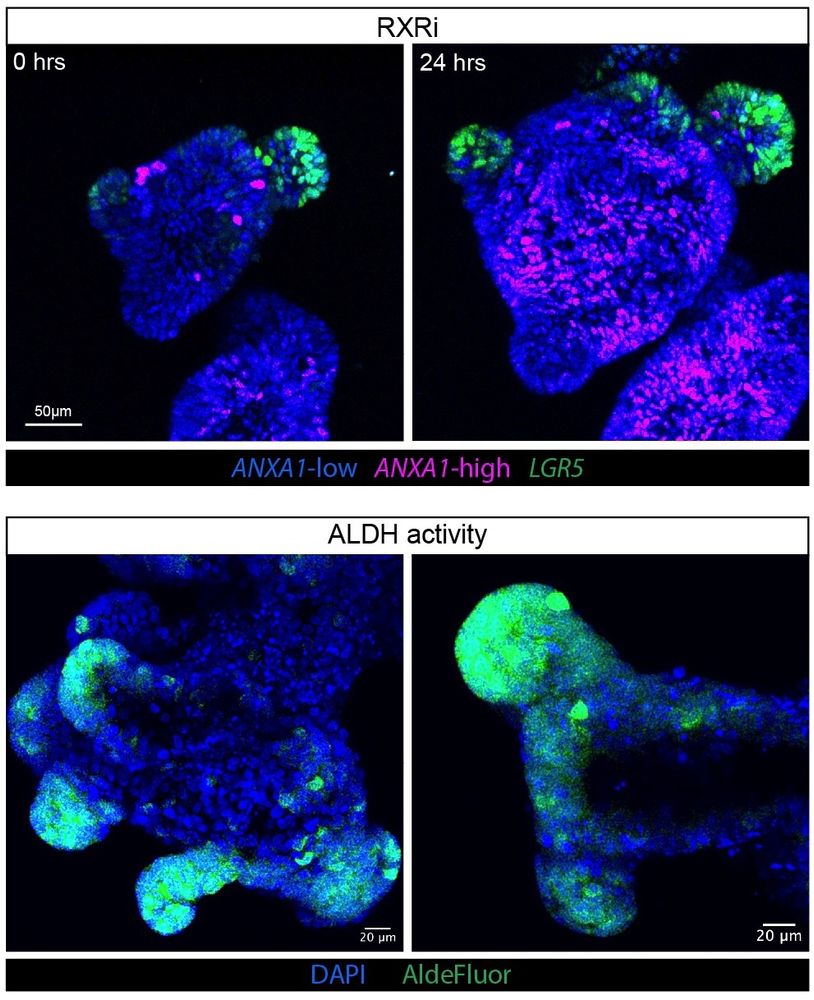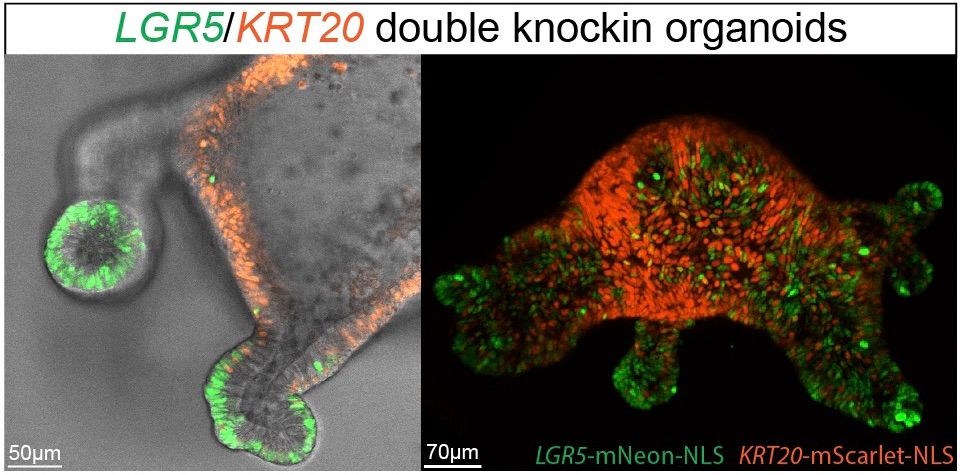Snippert lab
@hugosnippert.bsky.social
We use human organoid models to study the emergence and transformation of early-stage colorectal cancer.
We aim to prevent rather than cure.
Research lab at Prinses Maxima Center (formerly at UMC Utrecht) & Oncode Institute
We aim to prevent rather than cure.
Research lab at Prinses Maxima Center (formerly at UMC Utrecht) & Oncode Institute
6/ Many thanks to all co-authors, dear collaborators and funders. Especially the Dutch Research Council (NWO) for our ‘organoids in time’ consortium spearheaded by Jeroen van Zon
July 23, 2025 at 7:09 PM
6/ Many thanks to all co-authors, dear collaborators and funders. Especially the Dutch Research Council (NWO) for our ‘organoids in time’ consortium spearheaded by Jeroen van Zon
5/ Our tuft subtype-specific reporters and optimized differentiation strategy in organoids provide an experimental platform to study immune-related tuft cell subtypes and their unique cell biological properties, like signal perception, processing and transmission to trigger immune defense.

July 23, 2025 at 7:09 PM
5/ Our tuft subtype-specific reporters and optimized differentiation strategy in organoids provide an experimental platform to study immune-related tuft cell subtypes and their unique cell biological properties, like signal perception, processing and transmission to trigger immune defense.
4/ Adaptation of the crypt-like organoid medium to better mimic the villus environment, where tuft-2 cells reside in vivo, facilitates transitioning of post-mitotic immature tuft-1 states to the mature immune-related tuft-2 states that is ready for in-depth cell biological studies.
July 23, 2025 at 7:09 PM
4/ Adaptation of the crypt-like organoid medium to better mimic the villus environment, where tuft-2 cells reside in vivo, facilitates transitioning of post-mitotic immature tuft-1 states to the mature immune-related tuft-2 states that is ready for in-depth cell biological studies.
3/ Organoids with subtype-specific reporter knock-ins show that known tuft types in fact reflect successive maturation stages within the tuft lineage. Be aware 😱, commonly applied organoid treatment with IL-4 and 13 does lead to increased tuft numbers, but solely generates early tuft-1 states 🙅❌

July 23, 2025 at 7:09 PM
3/ Organoids with subtype-specific reporter knock-ins show that known tuft types in fact reflect successive maturation stages within the tuft lineage. Be aware 😱, commonly applied organoid treatment with IL-4 and 13 does lead to increased tuft numbers, but solely generates early tuft-1 states 🙅❌
2/ We analyzed single-cell intestinal tuft cell transcriptomes from mouse and human to reveal conserved proliferative tuft cell precursors (tuft-p), as well as abundant intermediaries of the previously described post-mitotic tuft-1 and tuft-2 cell states.
July 23, 2025 at 7:09 PM
2/ We analyzed single-cell intestinal tuft cell transcriptomes from mouse and human to reveal conserved proliferative tuft cell precursors (tuft-p), as well as abundant intermediaries of the previously described post-mitotic tuft-1 and tuft-2 cell states.
Thanks for the compliments Adam
July 23, 2025 at 8:28 AM
Thanks for the compliments Adam
8/ Thus, stem cell-derived retinoic acid actively suppresses plasticity in colonocytes, ensuring homeostasis and explaining how surviving cells sense stem cell loss. Please see preprint for detailed info. Concerning our favoured knock-in strategy, please see Bollen, Hageman et al., PLOS Biol 2022
July 16, 2025 at 7:37 PM
8/ Thus, stem cell-derived retinoic acid actively suppresses plasticity in colonocytes, ensuring homeostasis and explaining how surviving cells sense stem cell loss. Please see preprint for detailed info. Concerning our favoured knock-in strategy, please see Bollen, Hageman et al., PLOS Biol 2022
7/ Under homeostatic conditions, RXR is activated in colonocytes by RA produced by ALDH in stem cell compartments. But when the RA signal is lost (via stem cell loss or RXR inhibition), cells switch to an ANXA1-high regenerative state (visualized by independent ANXA1-RFP knock-in)

July 16, 2025 at 7:37 PM
7/ Under homeostatic conditions, RXR is activated in colonocytes by RA produced by ALDH in stem cell compartments. But when the RA signal is lost (via stem cell loss or RXR inhibition), cells switch to an ANXA1-high regenerative state (visualized by independent ANXA1-RFP knock-in)
6/ scRNA-seq and sc-multiome at high temporal resolution showed that predominantly surviving colonocytes first adopt a regenerative state marked by high ANXA1, before giving rise to new stem cells.

July 16, 2025 at 7:37 PM
6/ scRNA-seq and sc-multiome at high temporal resolution showed that predominantly surviving colonocytes first adopt a regenerative state marked by high ANXA1, before giving rise to new stem cells.
5/ Stem cell depletion triggered an unbiased and fast response with surviving cells quickly regenerating the LGR5+ stem cell pool. (normal organoids carrying 2 knock-ins: LGR5-GFP-DTR x KRT20-RFP-iCasp9)
July 16, 2025 at 7:37 PM
5/ Stem cell depletion triggered an unbiased and fast response with surviving cells quickly regenerating the LGR5+ stem cell pool. (normal organoids carrying 2 knock-ins: LGR5-GFP-DTR x KRT20-RFP-iCasp9)
4/ Next, knock-in of the Diphtheria Toxin Receptor into the LGR5 locus enabled selective stem cell ablation under normal conditions. Killing was robust, consistent and independent of low expression levels common to typical cell type markers (unlike inducible iCasp9)

July 16, 2025 at 7:37 PM
4/ Next, knock-in of the Diphtheria Toxin Receptor into the LGR5 locus enabled selective stem cell ablation under normal conditions. Killing was robust, consistent and independent of low expression levels common to typical cell type markers (unlike inducible iCasp9)
3/ First, we harnessed the power of genetic mouse models with selective cell type ablation. Except 😥, the widely used Diphtheria Toxin Receptor for cell killing is a common human receptor. 💡 We de-sensitised human organoids for D with a murinizing 🐭 point mutation in the endogenous entry factor.
July 16, 2025 at 7:37 PM
3/ First, we harnessed the power of genetic mouse models with selective cell type ablation. Except 😥, the widely used Diphtheria Toxin Receptor for cell killing is a common human receptor. 💡 We de-sensitised human organoids for D with a murinizing 🐭 point mutation in the endogenous entry factor.
2/ We found that human colon stem cells produce retinoic acid (RA), which acts as a “keep calm and carry on” signal to neighbouring cells, actively blocking their entry into a regenerative state. It explains how surviving cells sense stem cell loss 🔥
July 16, 2025 at 7:37 PM
2/ We found that human colon stem cells produce retinoic acid (RA), which acts as a “keep calm and carry on” signal to neighbouring cells, actively blocking their entry into a regenerative state. It explains how surviving cells sense stem cell loss 🔥
We thank all our co-authors to join us on our adventure and for their help!
👏👏 Big applause to our great first author @julian-buissant.bsky.social
👏👏 Big applause to our great first author @julian-buissant.bsky.social
December 1, 2024 at 8:45 PM
We thank all our co-authors to join us on our adventure and for their help!
👏👏 Big applause to our great first author @julian-buissant.bsky.social
👏👏 Big applause to our great first author @julian-buissant.bsky.social

